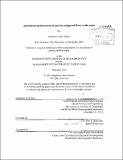| dc.contributor.advisor | Ken O. Buesseler. | en_US |
| dc.contributor.author | Owens, Stephanie Anne | en_US |
| dc.contributor.other | Woods Hole Oceanographic Institution. | en_US |
| dc.coverage.spatial | i------ | en_US |
| dc.date.accessioned | 2013-06-17T19:53:06Z | |
| dc.date.available | 2013-06-17T19:53:06Z | |
| dc.date.copyright | 2013 | en_US |
| dc.date.issued | 2013 | en_US |
| dc.identifier.uri | http://hdl.handle.net/1721.1/79284 | |
| dc.description | Thesis (Ph. D.)--Joint Program in Oceanography/Applied Ocean Science and Engineering (Massachusetts Institute of Technology, Dept. of Biology; and the Woods Hole Oceanographic Institution), 2013. | en_US |
| dc.description | Cataloged from PDF version of thesis. | en_US |
| dc.description | Includes bibliographical references. | en_US |
| dc.description.abstract | The sinking flux of particles is an important removal mechanism of carbon from the surface ocean as part of the biological pump and can play a role in cycling of other chemical species. This work dealt with improving methods of measuring particle export and measuring export on different scales to assess its spatial variability. First, the assumption of ²³⁸U linearity with salinity, used in the ²³⁸U-²³⁴Th method, was reevaluated using a large sample set over a wide salinity range. Next, neutrally buoyant and surface-tethered sediment traps were compared during a three-year time series in the subtropical Atlantic. This study suggested that previously observed imbalances between carbon stocks and fluxes in this region are not due to undersampling by traps. To assess regional variability of particle export, surface and water-column measurements of ²³⁴Th were combined for the first time to measure fluxes on ~20 km scales. Attempts to relate surface properties to particle export were complicated by the temporal decoupling of production and export. Finally, particle export from ²³⁴Th was measured on transects of the Atlantic Ocean to evaluate basin-scale export variability. High-resolution sampling through the water-column allowed for the identification of unique ²³⁴Th features in the intermediate water column. | en_US |
| dc.description.statementofresponsibility | by Stephanie Anne Owens. | en_US |
| dc.format.extent | 198 p. | en_US |
| dc.language.iso | eng | en_US |
| dc.publisher | Massachusetts Institute of Technology | en_US |
| dc.rights | M.I.T. theses are protected by
copyright. They may be viewed from this source for any purpose, but
reproduction or distribution in any format is prohibited without written
permission. See provided URL for inquiries about permission. | en_US |
| dc.rights.uri | http://dspace.mit.edu/handle/1721.1/7582 | en_US |
| dc.subject | Joint Program in Oceanography/Applied Ocean Science and Engineering. | en_US |
| dc.subject | Earth, Atmospheric, and Planetary Sciences. | en_US |
| dc.subject | Woods Hole Oceanographic Institution. | en_US |
| dc.subject.lcsh | Seawater Organic compound content Atlantic Ocean | en_US |
| dc.subject.lcsh | Seawater Carbon dioxide content Atlantic Ocean | en_US |
| dc.subject.lcsh | Carbon cycle (Biogeochemistry) Atlantic Ocean | en_US |
| dc.subject.lcsh | Salinity Atlantic Ocean | en_US |
| dc.subject.lcsh | Sediment transport Atlantic Ocean | en_US |
| dc.title | Advances in measurements of particle cycling and fluxes in the ocean | en_US |
| dc.type | Thesis | en_US |
| dc.description.degree | Ph.D. | en_US |
| dc.contributor.department | Joint Program in Oceanography/Applied Ocean Science and Engineering | en_US |
| dc.contributor.department | Woods Hole Oceanographic Institution | en_US |
| dc.contributor.department | Massachusetts Institute of Technology. Department of Biology | |
| dc.identifier.oclc | 846856143 | en_US |
